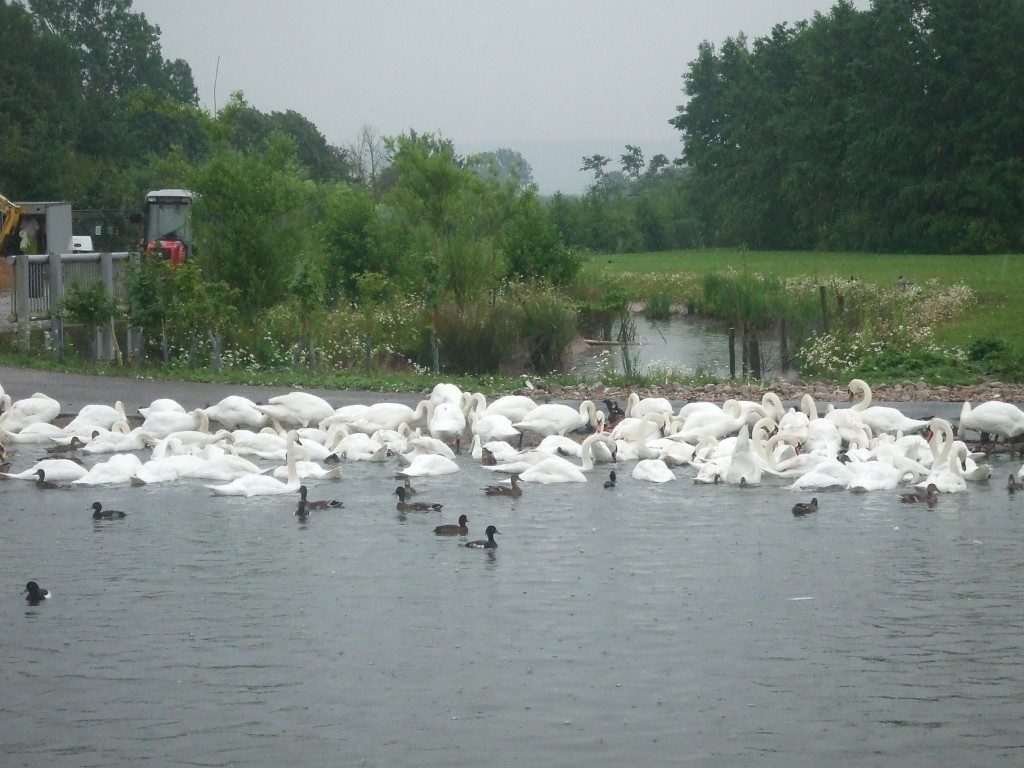Swan Courts? December 17, 2013
Author: Beach Combing | in : Medieval , trackbackA previous post offered up the legends of magpie parliaments and other collections of birds in assemblies. Here, instead is a medieval equivalent. Any knowledge of swans acting in groups in this way? drbeachcombing AT yahoo DOT com The events described here took place at Ongar in Essex probably in the twelfth century. The writer Gervase grew up near Ongar, this may have been a childhood story for him.
One day when the knights had gone to look at the aviaries of the house, there before them a large number of swans assembled in the meadow beneath the castle, and formed a kind of council. After they had conferred noisily together for a lon time, one of them stood out in their midst and made a long squawking accusation, acting just like a plaintiff or his advocate. Some swans on one side were posing as judges, and eventually they ordered the female in question to be brought forward. Two of them, sent by the judges, set the accused in the middle. After much hooting on all sides in the way of allegations, in the end the judges decided the case, and exposed the one found guilty of adultery to the whole flock. The assembly of swans sprang at the condemned creature, stripped her of her feathers, and having thus exposed her to the cold, delivered her up to the punishment of death.
Uno aliquot die cum ad exedras palacii milites se misissent ad prospiciendum, ecce multitude cignorum in prato domibus subiecto conuenit, et cum quasi concilio facto ad inuicem diu uocibus suis contulissent, unus e medio, sicut mos est accusatory uel eius patron, longo garritu querelam deponit, et cum ad unam partem quidam tanquam iudices se facerent., tandem produci mandant cignam. Duo igitur missi a judicibus ream in medio constituent, et post factas hinc inde garritiones uice allegationum, tandem iudices diffiniunt causam, ream adulterii toti gregi exponents. Insultat cignorum cetus, deplumat dampnatam, et sic frigori expositam mortis addicunt supplicio.
There are other stories where animals are judged for adultery and it is always, of course, this being the Middle Ages, the female/woman who is condemned. But in this case is it possible, in ornithological terms, that swans would gather together like this and then attack one of their own? Swans, for anyone who has not had close encounters, are fairly dangerous animals when provoked. Get between a mother and her young and you will suffer the wrath of Khan…
18 Dec 2013: An old friend of this blog KMH writes: Not to belabor this story excessively [KMH had exchanged emails], but the substitution of animals for humans is a well known, universal literary device. It is even found in the Bible (e.g., Christ calling his followers sheep). The writer is somehow able to interpret (has he ingested dragon’s blood?) the charge against the offending swan as adultery, but other charges are just as or even more likely, such as stealing a nest or a few cygnets. As you say, swans are known for instinctive lifetime fidelity. The final verdict where the female adulterer has her feathers torn out constitutes torture, requires so much energy, and is quite contrary to bird behavior. It would be more realistic if she were simply pecked to death by the other swans. If it were a human being, having her clothes torn off and being sent away totally naked might be a possible Medieval pagan penalty for adultery. However, the real circumstances of the case seem to be ignored, such as did the female have a mate at the time, or was she looking for a mate after her former one had died? As such, the story may be second or third hand and the details indicating it really referred to human beings were dropped over time.’ Chris from Haunted Ohio Books writes ‘Oh, on that swan trial–how did the witnesses know the female was accused of adultery and not assault, or arson? Had they been eating the flesh of a white snake to understand the language of birds?’ Thanks KMH and Chris!



